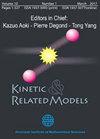非线性Vlasov-Poisson-Fokker-Planck系统的大摩擦-高力场极限
IF 1.5
4区 数学
Q1 MATHEMATICS
引用次数: 6
摘要
本文对具有大线性摩擦力和高力场的非线性Vlasov-Poisson-Fokker-Planck系统进行了定量渐近分析。极限系统是具有非局部速度场的扩散模型,通常称为聚集-扩散方程。我们证明了Vlasov-Poisson-Fokker-Planck系统的弱解强收敛于扩散模型的强解。我们的证明依赖于基于弱-强唯一性原理的调制宏观动能估计以及对泊松方程的仔细分析。本文章由计算机程序翻译,如有差异,请以英文原文为准。
Large friction-high force fields limit for the nonlinear Vlasov–Poisson–Fokker–Planck system
We provide a quantitative asymptotic analysis for the nonlinear Vlasov–Poisson–Fokker–Planck system with a large linear friction force and high force-fields. The limiting system is a diffusive model with nonlocal velocity fields often referred to as aggregation-diffusion equations. We show that a weak solution to the Vlasov–Poisson–Fokker–Planck system strongly converges to a strong solution to the diffusive model. Our proof relies on the modulated macroscopic kinetic energy estimate based on the weak-strong uniqueness principle together with a careful analysis of the Poisson equation.
求助全文
通过发布文献求助,成功后即可免费获取论文全文。
去求助
来源期刊
CiteScore
2.10
自引率
10.00%
发文量
36
审稿时长
>12 weeks
期刊介绍:
KRM publishes high quality papers of original research in the areas of kinetic equations spanning from mathematical theory to numerical analysis, simulations and modelling. It includes studies on models arising from physics, engineering, finance, biology, human and social sciences, together with their related fields such as fluid models, interacting particle systems and quantum systems. A more detailed indication of its scope is given by the subject interests of the members of the Board of Editors. Invited expository articles are also published from time to time.

 求助内容:
求助内容: 应助结果提醒方式:
应助结果提醒方式:


